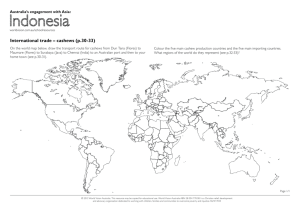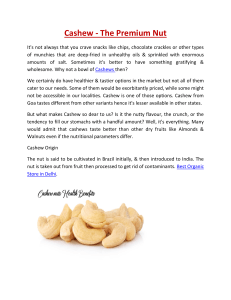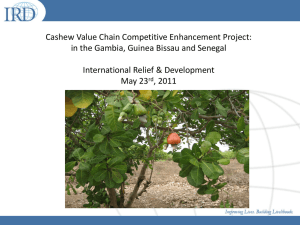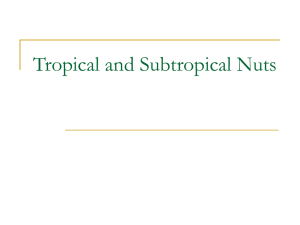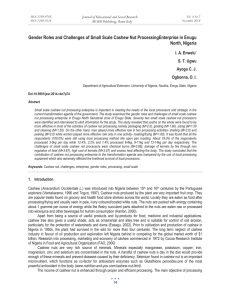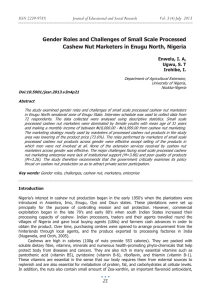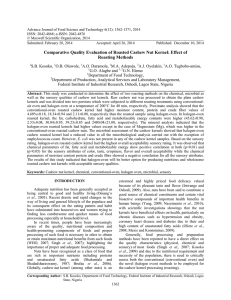Press Release - INC - International Nut and Dried Fruit
advertisement
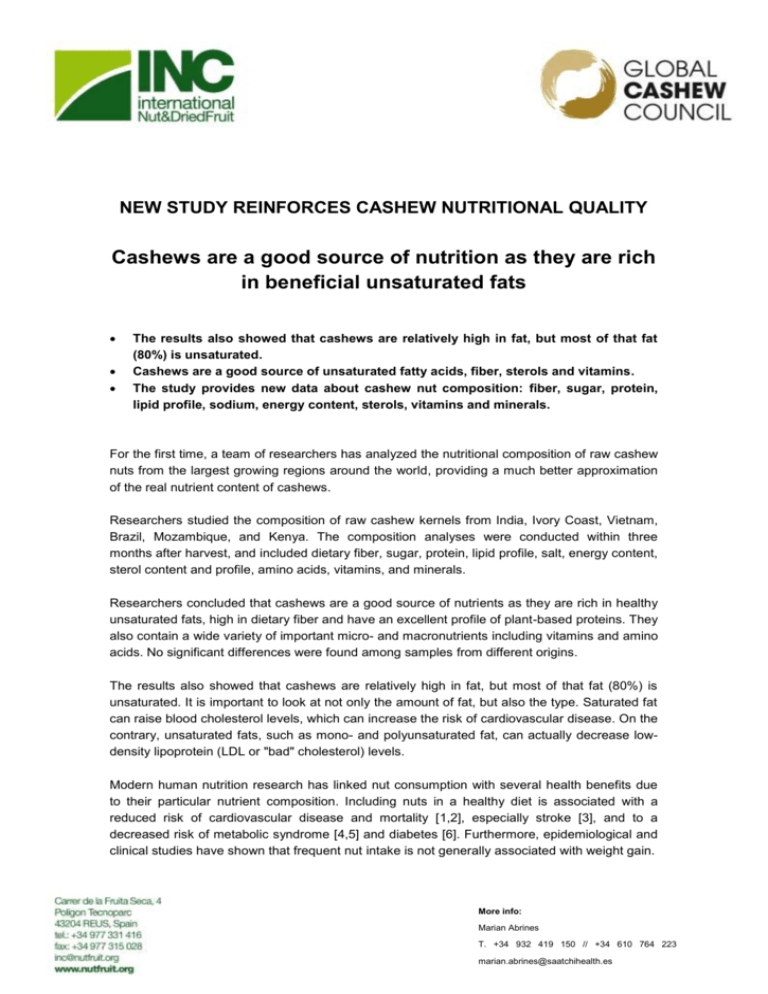
NEW STUDY REINFORCES CASHEW NUTRITIONAL QUALITY Cashews are a good source of nutrition as they are rich in beneficial unsaturated fats The results also showed that cashews are relatively high in fat, but most of that fat (80%) is unsaturated. Cashews are a good source of unsaturated fatty acids, fiber, sterols and vitamins. The study provides new data about cashew nut composition: fiber, sugar, protein, lipid profile, sodium, energy content, sterols, vitamins and minerals. For the first time, a team of researchers has analyzed the nutritional composition of raw cashew nuts from the largest growing regions around the world, providing a much better approximation of the real nutrient content of cashews. Researchers studied the composition of raw cashew kernels from India, Ivory Coast, Vietnam, Brazil, Mozambique, and Kenya. The composition analyses were conducted within three months after harvest, and included dietary fiber, sugar, protein, lipid profile, salt, energy content, sterol content and profile, amino acids, vitamins, and minerals. Researchers concluded that cashews are a good source of nutrients as they are rich in healthy unsaturated fats, high in dietary fiber and have an excellent profile of plant-based proteins. They also contain a wide variety of important micro- and macronutrients including vitamins and amino acids. No significant differences were found among samples from different origins. The results also showed that cashews are relatively high in fat, but most of that fat (80%) is unsaturated. It is important to look at not only the amount of fat, but also the type. Saturated fat can raise blood cholesterol levels, which can increase the risk of cardiovascular disease. On the contrary, unsaturated fats, such as mono- and polyunsaturated fat, can actually decrease lowdensity lipoprotein (LDL or "bad" cholesterol) levels. Modern human nutrition research has linked nut consumption with several health benefits due to their particular nutrient composition. Including nuts in a healthy diet is associated with a reduced risk of cardiovascular disease and mortality [1,2], especially stroke [3], and to a decreased risk of metabolic syndrome [4,5] and diabetes [6]. Furthermore, epidemiological and clinical studies have shown that frequent nut intake is not generally associated with weight gain. More info: Marian Abrines T. +34 932 419 150 // +34 610 764 223 marian.abrines@saatchihealth.es The study was undertaken by a group of researchers from Pere Virgili Health Research Institute (IISPV) and Rovira i Virgili University, in Spain. It was supported by the Global Cashew Council and the International Nut and Dried Fruit Council. The study is available to read, download and share at: http://onlinelibrary.wiley.com/doi/10.1002/fsn3.294/full About Cashews The cashew nut is native of northeast Brazil. During the 16th century, the Portuguese introduced it into India and Portuguese colonies in Africa such as Mozambique. From India, cashew trees spread all over South East Asia. The tree grows in tropical areas and is cultivated primarily in India, Vietnam, Côte d’Ivoire, Guinea-Bissau, Tanzania, Benin, Brazil, and other countries in East and West Central Africa and South East Asia. Plantings have also been established in South Africa and Australia. Among tree nuts, cashews rank third in world production, behind almonds and walnuts, with a world average production of 550,000 metric tons (kernel basis). In 2015, global production is estimated at 651,100 MT (kernel basis), led by India and Cote d'Ivoire with about 143,000 MT both, and followed by Vietnam (113,000 MT). About the Global Cashew Council The Global Cashew Council is aimed at promoting the growth and sustainability of the cashew nut sector by increasing awareness of the health and nutritional benefits of cashews, promoting usage and consumption, promoting food safety and quality standards, and supporting nutritional and health studies. About the International Nut & Dried Fruit Council The International Nut & Dried Fruit Council (INC) members include nearly 700 nut and dried fruit-sector companies from over 70 countries. INC is the international organization of reference regarding health, nutrition, statistics, food safety, international standards and regulations relating to nuts and dried fruit. References: 1. Kris-Etherton PM, Hu FB, Ros E, Sabate J. The role of tree nuts and peanuts in the prevention of coronary heart disease: multiple potential mechanisms. J Nutr 2008;138:1746S-1751S. 2. Ros E, Tapsell LC, Sabate J. Nuts and berries for heart health. Curr Atheroscler Rep 2010;12:397-406. More info: Marian Abrines T. +34 932 419 150 // +34 610 764 223 marian.abrines@saatchihealth.es 3. Estruch et. al. Primary prevention of cardiovascular disease with a Mediterranean diet. N Engl J Med 2013; 368:1279-1290. 4. Mitjavila MT, Fandos M, Salas-Salvadó J, Covas MI, Borrego S, Estruch R, Lamuela-Raventós R, et al. The Mediterranean diet improves the systemic lipid and DNA oxidative damage in metabolic syndrome individuals. A randomized, controlled, trial. Clinical Nutrition. Available online 30 August 2012. 5. Fernández-Montero A, Bes-Rastrollo M, Beunza JJ, Barrio-Lopez MT, de la Fuente-Arrillaga C, Moreno-Galarraga L, Martínez-González MA. Nut consumption and incidence of metabolic syndrome after 6-year follow-up: the SUN (Seguimiento Universidad de Navarra, University of Navarra Follow-up) cohort. Public Health Nutrition 2012; Oct 23; 1-9. 6. Kendall CW, Esfahani A, Josse AR, Augustin LS, Vidgen E, Jenkins DJ. The glycemic effect of nut-enriched meals in healthy and diabetic subjects. Nutr Metab Cardiovasc Dis 2011; May 9. More info: Marian Abrines T. +34 932 419 150 // +34 610 764 223 marian.abrines@saatchihealth.es
